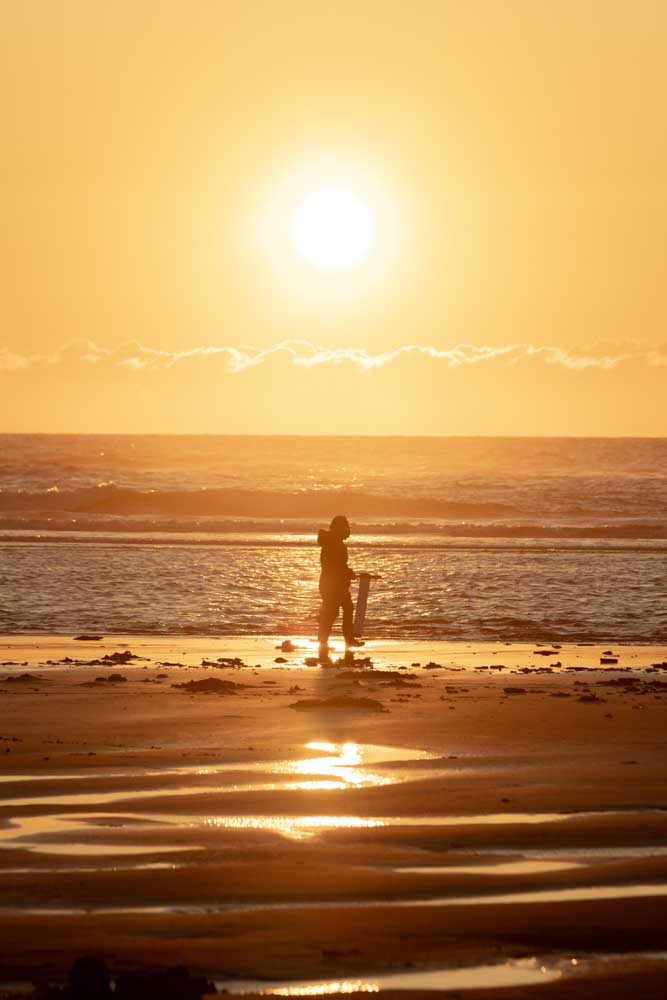State OKs next set of clam digs
Published 12:25 pm Wednesday, January 22, 2025

- A setting sun silhouetted a clam digger at the start of the successful 2023-24 season.
OLYMPIA — Washington Department of Fish and Wildlife shellfish managers confirmed the next razor clam digs on coastal beaches.
“Diggers can look forward to another week of razor clamming,” said Bryce Blumenthal, WDFW’s recreational razor clam manager. “Success can be spotty this time of year, so don’t be afraid to walk or drive to a different area of beach and remember to stomp and pound the sand to make the clams show.”
Not all coastal beaches are open for every dig, so diggers are encouraged to make sure their intended destination is open before heading out. No digging is allowed before noon during digs when low tide occurs in the afternoon or evening. Most successful digging occurs between one and two hours before the listed time of low tide.
The following digs during evening (p.m.) low tides will proceed as scheduled, after marine toxin results from the Washington State Department of Health showed razor clams are safe to eat:
• Jan. 26, Sunday, 4:34 p.m.; 0.1 feet; Long Beach, Twin Harbors, Mocrocks
• Jan. 27, Monday, 5:15 p.m.; -0.4 feet; Long Beach, Twin Harbors, Mocrocks
• Jan. 28, Tuesday, 5:54 p.m.; -0.8 feet; Long Beach, Twin Harbors, Copalis
• Jan. 29, Wednesday, 6:31 p.m.; -1.0 feet; Long Beach, Twin Harbors, Copalis
• Jan. 30, Thursday, 7:07 p.m.; -1.0 feet; Long Beach, Twin Harbors, Mocrocks
• Jan. 31, Friday, 7:44 p.m.; -0.7 feet; Long Beach, Twin Harbors, Mocrocks
• Feb. 1, Saturday, 8:21 p.m.; -0.1 feet; Long Beach, Twin Harbors, Copalis
Below are additional tentative dates:
• Feb. 8, Saturday, 3:36 p.m.; 0.1 feet; Long Beach, Twin Harbors, Mocrocks
• Feb. 9, Sunday, 4:29 p.m.; -0.3 feet; Long Beach, Twin Harbors, Copalis
• Feb. 10, Monday, 5:15 p.m.; -0.5 feet; Long Beach, Twin Harbors, Copalis
• Feb. 11, Tuesday, 5:54 p.m.; -0.5 feet; Long Beach, Twin Harbors, Mocrocks
• Feb. 12, Wednesday, 6:29 p.m.; -0.4 feet; Long Beach, Twin Harbors, Mocrocks
• Feb. 13, Thursday, 7:01 p.m.; -0.1 feet; Long Beach, Twin Harbors, Copalis
• Feb. 14, Friday, 7:32 p.m.; 0.4 feet; Long Beach, Twin Harbors, Copalis
• Feb. 24, Monday, 4:04 p.m.; 0.2 feet; Long Beach, Twin Harbors, Mocrocks
• Feb. 25, Tuesday, 4:46 p.m.; -0.3 feet; Long Beach, Twin Harbors, Copalis
• Feb. 26, Wednesday, 5:25 p.m.; -0.6 feet; Long Beach, Twin Harbors, Copalis
• Feb. 27, Thursday, 6:03 p.m.; -0.7 feet; Long Beach, Twin Harbors, Mocrocks
• Feb. 28, Friday, 6:39 p.m.; -0.6 feet; Long Beach, Twin Harbors, Mocrocks
• March 1, Saturday, 7:15 p.m.; -0.1 feet; Long Beach, Twin Harbors, Copalis
DOH requires test samples for marine toxins, and domoic acid levels must fall under the guideline level before a beach can open for digging. Domoic acid, a natural toxin produced by certain types of marine algae, can be harmful or fatal if consumed in sufficient quantities.
Final approval usually occurs about a week or less before the start of each digging series. More information about domoic acid, as well as current levels at ocean beaches, can be found on WDFW’s domoic acid webpage. The most recent testing found a maximum of 2 parts per million in clams from Long Beach/Ocean Park and Tokeland/Westport.
On all open beaches, the daily limit is 15 clams per person. Each digger’s clams must be kept in a separate container, and all diggers must keep the first 15 clams they dig, regardless of size or condition, to prevent waste.









